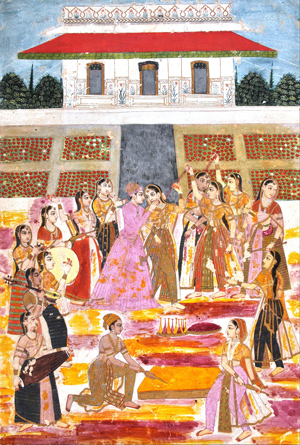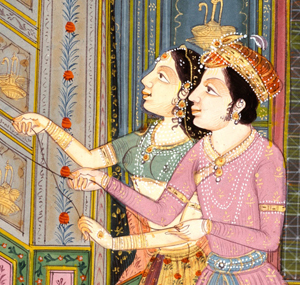
Your complimentary articles
You’ve read one of your four complimentary articles for this month.
You can read four articles free per month. To have complete access to the thousands of philosophy articles on this site, please
Articles
Hedonism in Ancient India & Greece
Nick Gutierrez wonders if pleasure-seeking is underrated as a virtue.
In this article I want to examine an ethical theory that has never been quite as well-received as some others: hedonism. It’s an ancient theory, with well-documented precedents in both ancient Greece and India. My first aim is to introduce the doctrine of hedonism. I’ll provide a rough description of what hedonism is and what it looks like, based on Fred Feldman’s distinction between sensory pleasures and attitudinal pleasures. My second aim is to respond to charges of mysticism leveled at Asian philosophy. After my overview of hedonism, I’ll describe the ancient Indian Cārvāka school, a form of hedonism that was notably naturalistic or anti-mystical. I will then compare this Ancient Indian form of hedonism with an Ancient Greek form, namely Epicureanism. By comparing and contrasting the Indian hedonists with their Greek counterparts, and by illustrating how well-developed and varied hedonism actually is, my hope is that we can revisit hedonism as a viable ethical theory while simultaneously moving beyond the traditional dismissal of Asian philosophy found in the West.
What Is Hedonism?

Epicurus, original Greek hedonist
Portrait © Clinton Inman 2020. Facebook him at clinton.inman
In its most basic form, hedonism argues that one ought to pursue pleasure and avoid pain as the fundamental aim of human behaviour.
This idea’s popularity through the ages has been fickle. For example, despite the influence of Epicurus around the Mediterranean in the Hellenistic period, Plato’s Academy and Aristotle’s Lyceum were the more influential schools of philosophy, with Aristotle’s exposition of virtue ethics commonly considered a cornerstone of classical antiquity. By contrast, Bentham’s development of utilitarian ethics around the end of the eighteenth century was considered scandalous at the time, primarily because it revived the notion of pleasure as the highest good. Indeed, it would seem as if hedonism has usually been vilified to some degree throughout the various epochs of culture, and frequently banished to the periphery of discussions on ethics.
A number of common criticisms have kept hedonism in the fringes. Cicero (106-43 BCE), a vehement critic of Epicurus, refers to the pursuit of pleasure as “the sort of position that seems utterly unworthy of a human being”, claiming that “Nature has created and shaped us for better things” (On Moral Ends). The utilitarian John Stuart Mill mentions that “such a theory of life excites in many minds…inveterate dislike… to suppose that life has (as they express it) no higher end than pleasure…they designate as utterly mean and groveling; a doctrine worthy only of swine” (Utilitarianism, Ch. 2, 1863). And in Principia Ethica (1903), G.E. Moore rejected the idea that something is valuable simply because someone finds it pleasant, suggesting that a world consisting of nothing more than a ‘heap of filth’ will always be less preferable than a world of vibrant beauty. But is this a fair representation of hedonism? Does hedonism invariably reduce humans to animals? Even if it did, would the hedonist see this as a problem?
For proponents of hedonism, the situation is more nuanced than these criticisms would lead us to believe. I will focus my efforts on one particular theory put forward by the American ethicist Fred Feldman, which I think gives the hedonist an initial response to the above criticisms and a starting point for further discussion. For Feldman, an important distinction should be made between what he calls ‘sensory pleasures’ and ‘attitudinal pleasures’. (John Stuart Mill also emphasised a similar distinction between types of pleasure.) Sensory pleasures can be correlated with physical sensations, while attitudinal pleasures are better correlated with ‘feelings of enjoyment’, where enjoyment is an attitude, not a sensation. Eating for the pleasure of the feeling is one example of sensory pleasure, while those who pursue attitudinal pleasures aim to maximize the pleasures of the mind rather than the pleasures of the body; for instance the feeling of enjoyment one has after solving a difficult puzzle, or coming to a particular philosophical understanding.
Feldman’s distinction between sensory and attitudinal pleasures is important in a number of ways. First, it provides a framework in which we can develop a kind of taxonomy of hedonist theories. It allows us to distinguish between hedonists who advocate the pursuit of sensory pleasures, and those who advocate the pursuit of attitudinal pleasures. The advantage of such a taxonomy is that it gives the hedonist potential responses to the commonest criticisms often directed at him. For example, it strikes me as far from appropriate to claim that hedonism is a ‘doctrine of swine’ if the hedonist is advocating the pursuit of attitudinal pleasures, or pleasures of intellectual contemplation, not sensory ones.
A second advantage of Feldman’s theory is that it provides us with a good approach to understanding what pleasure is. One of the historic hurdles in discussing hedonism has been that hedonists have often disagreed as to what pleasure actually is and so what the pursuit of it entails. Even the ancients disagreed sharply about the nature of pleasure, as we will see. Feldman’s view essentially addresses this hurdle by splitting pleasure into two categories, resulting in two different starting points.
There’s nothing stopping the hedonist from pursuing both sensory and attitudinal pleasures. However, sometimes the pursuit of one conflicts sharply with the pursuit of the other. We can imagine a situation, for example, in which someone is both a proud parent and a lover of heroin. We can easily see how pursuing the sensory pleasures brought about by indulging in heroin would be starkly at odds with the attitudinal pleasures of being a good role model for one’s child.

Image © Venantius J Pinto 2020. To see more art, please visit flickr.com/photos/venantius/albums
The Cārvāka
The genesis of hedonism as an ethical theory is often located in Ancient Greece. However, there is evidence of a school of hedonism developing in India independent of Greek influence. In the Classical period, philosophy in India was overwhelmingly dominated by Hinduism. The Vedas, the ancient scriptures of the Hindus, are dated having been compiled anywhere from between 1700-1100 BCE.
By the time of the Cārvākas, around the time of the Buddha (6th-5th C. BCE), the six orthodox schools of Hinduism had already considered valid means of knowledge and the good life extensively. One of a number of heterodox schools of Indian philosophy, the Cārvākas rejected almost all of the standard Hindu means of knowledge, were staunch materialists, and considered pleasure as the goal of a good life, denying the pursuit of the kind of liberation from desire advocated by Hindus and Buddhists alike. For many schools of Indian philosophy, the self or soul persists through many lifetimes, and how subsequent lives manifest is contingent on one’s actions (this is karma), and liberation from this cycle of rebirth is attained through enlightenment, which frequently involves the denial of one’s desires. The Cārvākas, however, don’t seem preoccupied with breaking the cycle of rebirth: they are very much rooted in the present, and in the sensations of the here and now.
Unfortunately, the ancient writings of the Cārvākas themselves have been lost to history. As Radhakrishnan notes, “the main work on the system, the Brhaspati Sutra, is not available, and we have to reconstruct the doctrines of materialism from statements of the position and criticism of it found in polemical and other works” (A Sourcebook in Indian Philosophy, p.227, 1957). There are two fragments in particular that I will refer to: the Sarvadarsanasamgraha and the Sarvasiddhantasamgraha.
The Sarvadarsanasamgraha attributes to the Cārvākas the maxim, “the only end of man is enjoyment produced by sensual pleasures”. A short verse in the text also mentions that “while life is yours, live joyously”, while yet another fragment declares that “the mass of men, in accordance with the Sāstra of policy and enjoyment, considering wealth and desire the only ends of man and denying the existence of any object belonging to a future world, are found to follow only the doctrine of Cārvāka”. The Cārvākas maintained that one can understand the world only through sense perception. They denied the validity of the other means of knowledge advocated by Hindu schools: as the Sarvadarsanasamgraha puts it: “the only Supreme is the earthly monarch whose existence is proved by all the world’s eyesight”. Since any future worlds visited upon death are not readily confirmable by the senses, the Cārvākas deny that such future worlds exist. By denying the existence of future worlds or reincarnation, they also undermine the kind of morality advocated by Hinduism. There is no need to pay attention to your actions in the present if there is no future destiny to be influenced by them. What the Cārvākas are left with is a life dedicated to the pursuit of pleasure.
For the Cārvākas, the drive towards pleasure is also evidenced by human nature. As argued in the Sarvadarsanasamgraha, “it is not therefore for us, through a fear of pain, to reject the pleasure which our nature instinctively recognizes as congenial.”
We begin to see how the doctrines of the Cārvākas can be interpreted as an ancient form of hedonism. But what kind of hedonism did they advocate? If we examine the Cārvākas through the lens of Feldman’s distinction, were they proponents of sensory or of attitudinal pleasures?

An average day in Ancient India
Well, according to the Sarvasiddhantasamgraha, the Cārvākas maintained that “the enjoyment of heaven lies in eating delicious food, keeping company of young women, using fine clothes, perfumes, garlands, [and] sandal paste.” And the Cārvākas didn’t let anything stop them from enjoying life, as illustrated by an earlier claim in the Sarvadarsanasamgraha that “while life remains let a man live happily, let him feed on ghee even though he runs into debt.” They also vehemently decried the abstinence typical of Hindu ascetics, arguing that “chastity and other such ordinances are laid down by clever weaklings”, instead preferring to argue for the sensual indulgences mentioned. This dedication to indulgence was not to be hampered by the social conventions of mainstream Hindu society, such as debt or devotion or belief in karma, and it is also consistent with their views on knowledge. If the only means of experiencing the world is through sense perception, and the highest good is pleasure, then it makes sense that the Cārvākas would consider pleasure a phenomenon of the senses. Of course, by advocating the pursuit of sensory pleasure, the Cārvākas are then vulnerable to some of the criticisms I mentioned earlier. Cicero would undoubtedly disapprove of the Cārvāka position as ‘utterly unworthy of a human being’, and Mill would likely acknowledge that it sounds much like the ‘doctrine of swine’ that critics are quick to describe hedonism as.
The Epicureans
In the timeline of Ancient Greek philosophy, Epicureanism was a late innovation. Epicurus was born on the island of Samos in 341 BC. This puts his birth and upbringing in the later stages of Aristotle’s life, and after the death of Plato in 348 BC. Aristotle had already produced a large corpus of work by the time Epicurus began practicing philosophy.
Epicurus and his followers were also not the first Greeks to argue that pleasure is the highest good. Aristippus of Cyrene (c.435–c.356 BCE) is generally credited as advocating a life of pleasure well before Epicurus. However, what sets Epicurean hedonism apart from Cyrenaic hedonism is the kind of pleasure that Epicurus and his followers advocated. Using Feldman’s distinction, the Epicureans were very much in favor of pursuing attitudinal pleasures, the pleasures of the mind, in contrast to the pleasures of the senses and the body favored by the Cyrenaics and the Cārvākas.

Unlike the Cārvākas, there are numerous primary sources preserved from the ancient period concerning Epicurus and his followers. I will focus on two: Epicurus’ Letter to Menoeceus, and Cicero’s On Moral Ends. In the Letter, Epicurus writes that “pleasure is the starting point and goal of living blessedly”, and that “we do everything for the sake of being neither in pain nor in terror”. In On Moral Ends, the young Torquatus takes up the task of defending Epicureanism, arguing that “every animal as soon as it is born seeks pleasure and rejoices in it, while shunning pain as the highest evil and avoiding it as much as possible. This is behavior that has not yet been corrupted, when nature’s judgment is pure and whole.” One may notice an interesting parallel between this argument and an argument given in the Sarvadarsanasamgraha: for both the Epicureans and the Cārvākas, the pursuit of pleasure is part of human nature. As the Cārvākas claimed, “it is not therefore for us, through a fear of pain, to reject the pleasure which our nature instinctively recognizes as congenial.”
However, the similarities pretty much end here, and Epicurean hedonism begins to take a radical departure from that of the Cārvākas and the Cyrenaics. Perhaps Epicurus had the latter in mind when he writes in the Letter that “when we say that pleasure is the goal we do not mean the pleasures of the profligate or the pleasures of consumption, as some believe… but rather the lack of pain in the body and disturbance in the soul.” A similar sentiment is echoed in On Moral Ends, when Torquatus explains that “we do not simply pursue the sort of pleasure which stirs our nature with its sweetness and produces agreeable sensations in us: rather, the pleasure we deem greatest is that which is felt when all pain is removed.” For the Epicureans, the height of pleasure was the absence of pain. Some may find it strange to say that out of all pleasures, the greatest isn’t an indulgence in or an achievement of something, but rather an absence of something. Even among hedonists, such a view is a radical one. But the Epicureans leave little room for ambiguity in their view. As Epicurus himself argues in the Letter :
“It is not drinking bouts and continuous partying and enjoying boys and women, or consuming fish and the other dainties of an extravagant table, which produce the pleasant life, but sober calculation which searches out the reasons for every choice and avoidance and drives out the opinions which are the source of the greatest turmoil for men’s souls.”
Despite such a refined view of pleasure Epicurus was able to develop a theory based on it. Epicurus’ prescription for the good life outlined in the Letter famously includes the maxim that ‘the limit of good things is easy to achieve completely, and easy to provide’. The hedonist who views pleasure as constant indulgence in partying and other sensual objects, an Epicurean would argue, is setting himself up for disappointment when these things are no longer within his means. However, the hedonist who understands that the greatest pleasure is freedom from pain seeks contentment in a frugal and simple life, and will always be ready to cope with life’s struggles. Indeed, it seems clear that the Epicureans would certainly be proponents of attitudinal rather than sensory pleasures. They definitely don’t seem susceptible to the criticisms of hedonism we noted. Despite Cicero’s claim that the pursuit of pleasure is ‘totally unworthy of a human being’, it’s not entirely clear how the ‘sober calculation’ and ‘lack of pain in the body’ that the Epicureans strive for is any less worthy a pursuit than any of the virtues advocated by, say, the followers of Aristotle.
Conclusion
There are two main points that I hope readers will walk away with. First, hedonism is not a call to unbridled debauchery, but rather, can be a developed ethical theory just as viable as any of its more popular competitors. As Feldman illustrates, even the concept of pleasure itself is more complex than we often consider; and having an appropriate understanding of pleasure is paramount in both developing and critiquing hedonistic theories. Indeed, the distinction between sensory and attitudinal pleasures allows us to illustrate the difference between forms of hedonism as ancient as the Cārvākas and the Epicureans, while simultaneously allowing us to provide a response to some of the popular criticisms of hedonism. Granted, one may argue that I’m applying Feldman’s distinction to the Cārvākas and the Epicureans anachronistically, and that by trying to conform the ancient theories to a modern mold in this way, I may be attributing a distinction to them that would be foreign to ancient thought.
I understand that there is always a risk in applying modern concepts to ancient theories (and vice versa). In this case, however, I believe it’s permissible. If I may be so bold, I’m willing to bet that Feldman’s inspiration for making his distinction in the first place is rooted in the very antagonism between the Cyrenaics and the Epicureans concerning pleasure. The ancient sources themselves – even Epicurus himself – are careful to distance the hedonism of Epicurus from that of Aristippus. As Epicurus explained in the Letter to Menoeceus, he isn’t interested in ‘the pleasures of the profligate or the pleasures of consumption’.
My second takeaway idea is that Ancient Asian philosophy can provide the same depth of insight as can the European philosophical tradition. One hardly ever finds mention of anything other than the champions of Western philosophy in your typical Philosophy 101 course, and Asian philosophy is often ignored as mystical or overly religious. However, the Cārvākas have shown us that there were dissenters even in ancient India who objected to the kinds of mysticism that irk Western atheists today. And this is of course only one school of Ancient Indian thought. There remain other innovations in the history of Asian philosophy that would merit further exploration by modern Western thinkers.
© Nick Gutierrez 2020
Nick Gutierrez is a communications consultant and independent writer based in the Seattle area. He received his MA in Philosophy from San Diego State University and is interested in literature and art.








